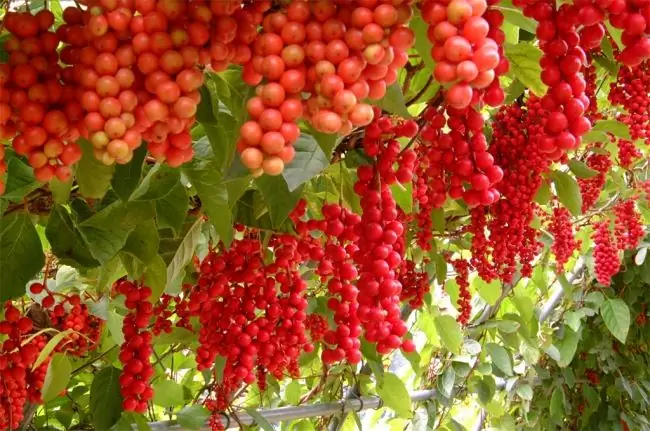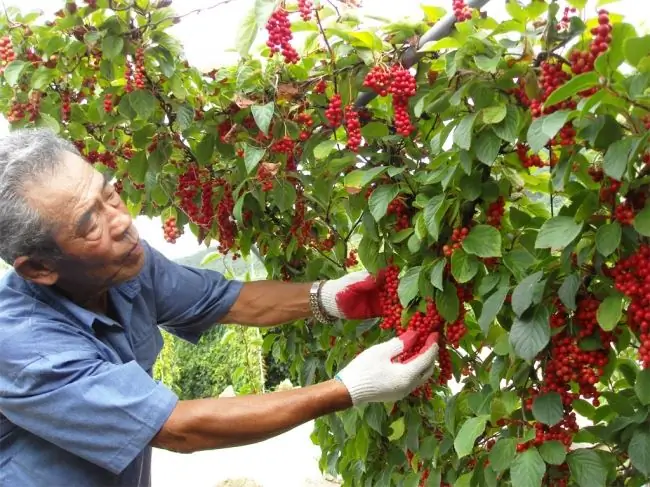- Author Arianna Cook [email protected].
- Public 2023-12-17 14:23.
- Last modified 2025-01-23 09:40.
The article describes the botanical features of Schisandra chinensis, its use in medicine and cooking, and some principles of agricultural technology Schisandra chinensis is a woody liana. On the territory of Russia, it grows in the mixed forests of the Far East. Clinging to rocks and trees, it rises up to 15 meters above the ground. Leaves are bright green with pink petioles. White flowers are formed in the axils of the leaves, 2-3 pcs. The petals of the flowers are white; males have yellow stamens, and females have a large greenish pistil.
The plant owes its name to the aroma exuded by all its parts when rubbed. The Chinese, who value lemongrass highly, call it "the fruit of five tastes." Indeed, the shell of the berry is sweet, the pulp has a sour taste, the seeds are bitter, and when stored, astringency and salty taste appear.
The chemical composition of berries and medical applications
Schisandra is almost as prized in oriental medicine as the miraculous ginseng. Scientists have proven its stimulating effect on the human body by isolating a substance from berries and leaves schizandrin … Also present ascorbic acid, pectin, saponins, many organic acids. All this allows the use of lemongrass in the treatment of many diseases, in particular, gastritis, nephritis, some diseases of the cardiovascular system, disorders of the gallbladder. It is also used in psychotherapy: in small doses, lemongrass helps fight depression. The fruit infusion is an excellent antiscorbutic agent.

It is worth remembering that lemongrass is somewhat increases blood pressure, therefore, hypertensive patients need to use it carefully. Since schizandrin has a general stimulating effect on the body, it can aggravate insomnia and other anxiety conditions.
Application in cooking and cosmetology
Cooking, of course, did not ignore this wonderful plant. Juice, syrup, jam and all kinds of drinks are prepared from berries. The juice is an excellent color for confectionery and also gives them a lemon flavor. Vine leaves are able to fully replace tea. The fruits, ground with sugar, are stored in the refrigerator until spring, when the loss of energy and vitamin deficiency are especially noticeable. The essential oil of the fruit is often included in lotions and creams. It keeps the skin firm and elastic. In the old days, lemongrass was used to prevent hair loss by rubbing the mucus under the bark of the vine into the skin.
Growing and caring for Chinese lemongrass
Lemongrass is not only useful, it is also extremely decorative. It is good to use it for landscaping gazebos and other recreation areas. It will delight the eye from spring, when bright greens with reddish veins are adorned with waxy flowers, and until autumn, when the clusters of berries turn bright red and the foliage turns orange. And throughout the season, the gazebo will be fragrant with an invigorating aroma.
In nature, liana grows on air-permeable rich soils, near water bodies. Therefore, in the garden, she needs to provide similar conditions. The soil should be well drained; for this purpose, a bucket of expanded clay or pebbles is poured into the bottom of the hole. Garden soil is mixed with peat and mineral fertilizer is added. Fresh manure cannot be applied under the plant.
If the leaves turn light green, then lemongrass receives excess light. Lack of it will also affect fruiting. It is optimal if the vine receives direct sunlight in the morning and evening, and in the afternoon it turns out to be in partial shade. For better pollination, you need to try to maintain the lightness and delicacy of the bush, cutting out weak, diseased and old shoots.

Bunches of lemongrass
Abundant, one flower produces a long cluster containing up to 40 berries. Inside the berry there are two yellow seeds. The vine begins to bear fruit 4 years after planting. Multiply can be green cuttings and seeds.
The plant definitely needs support. Creeping on the ground, lemongrass gives a lot of root shoots and new shoots, but never blooms.
To obtain a harvest, it is better to have several copies of the plant. The fact is that on one liana there can be purely female or male flowers, but there are also monoecious forms. Unfortunately, it is possible to identify a monoecious specimen only after the beginning of fruiting.



